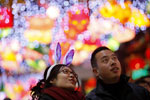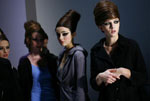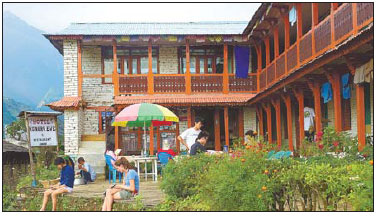Editor's Pick
Abode of the gods
Updated: 2011-01-27 07:11
By Liu Yi-ling (China Daily)
Other locals worked at the many lodges dotting the way with names such as "Hungry Eye" and "Sherpo Lodge", where we stocked up on glass bottles of coke, melted Twix bars and Nepalese Tea.
At mealtimes, we huddled around a rectangular table, chatting, playing cards, and rewinding after a hard day's work. The food was mostly Nepalese fare, dahl (lentils), rice, curry, and chapatti, accompanied by a variety of American Diner-type dishes, such as potatoes, buttered rolls and a bizarre desert - the Snickers roll (baked chocolate bars).
|
Hotel Hungry Eye, one of the many lodges scattered along the trail. |
Whatever the delicacy served, we shoveled it into our mouths with enthusiasm. We devoured anything edible. The Himalayas have a way of curing picky eaters.
Days typically started at 6 am and ended at 8:30 pm, when the sky turned pitch black. Guided by the soft glow of our headlamps, we would then shuffle to our rooms, and collapse on the beds and savor the delicious warmth of our sleeping bags.
Solar-powered hot showers in tin huts, were a luxury. However, if we did manage to scrape a hot shower and enjoyed more than five minutes of steaming bliss, we would suffer, inevitably, from the vicious glares of fellow hikers.
Each day of the trek, the altitude rose, forcing us to down a white Diamox pill (to combat altitude sickness) with our breakfast. We also began to get clearer views of the snow-capped, 7,000-meter high Mount Macchapachure, dubbed "Fishtail" after its pointed double summit. Considered sacred to the God Shiva, it's off limits to hikers.
It rained on our final day toward the foot of Mount Macchapachure, an incessant, frustrating drizzle that clung to our ponchos and soaked our packs.
We watched our feet intently, cautious not to step on ubiquitous piles of cowpat, wondering how on earth a cow had managed to find its way up all those jagged stone steps that had taken us hours to climb. With the entire landscape encased in a thick fog, all we could do was walk on blindly, knowing that the majestic fishtail loomed somewhere in the distance.
The climax of our trek, however, was walking to Annapurna Base Camp, waking up at 3:30 am, clad in full gear - thermals, fleeces, goose-downs, outer ski-layers - and making our way single file through the darkness.
We arrived just in time to see Annapurna wake up. The fog lifted and the peaks, from Annapurna I to Hintchuli, became visible in the sunlight.
For a moment, we felt miniscule, insignificant, dwarfed by these majestic peaks. Annapurna I, that soars 8,091 meters into the sky, is the 10th highest summit in the world. The mountains, so rugged, so white and pristine, and so untouched by man, seemed to be daring us to take them on.
We had reached the end of our trip and I thought about the others, Frenchman Maurice Herzog in the 1950s, alpinist Ian Clough in the 70s, for whom reaching the base camp was only the beginning.
Would I come back and try to join the list of successful mountaineers? The prospect, I must say, while I stood at the foothills, gazing upwards at the peaks, was tempting.
But, alas, that is for another time. After a dozen more camera flashes and several mugs of hot chocolate, we began our return trek - a big relief.
We were sunburned, hungry, covered in grime and sweat and had blisters the size and shape of beetles in between our toes - and yet we were full of euphoria.
I was elated and feeling smug - we had trekked over 94.45 km and climbed 10,173 meters.
All I needed was a hot, steaming shower.
Specials

Kremlin buddies
Dmitry Medvedev and Vladimir Putin inspect Olympic preparations.

Lantern Festival
The Lantern Festival is celebrated across China.

New York Fashion Week
Models line up before a show during New York Fashion Week.
